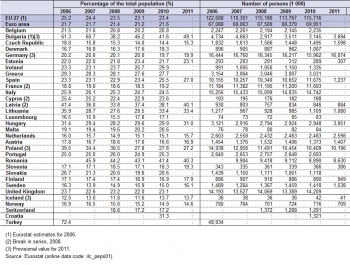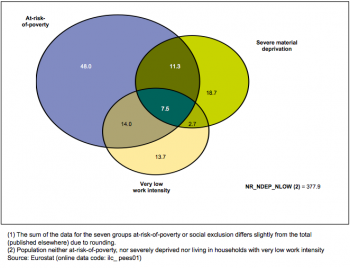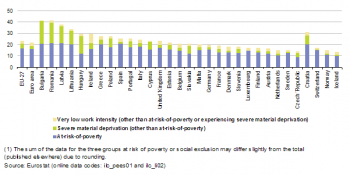Archive:Social inclusion statistics
Data from August 2012. Most recent data: Further Eurostat information, Main tables and Database.
Social inclusion has long been a key part of the European Union's (EU) policies. The overriding goal is to reduce substantially the number of people at-risk-of-poverty or social exclusion, thereby creating a socially inclusive society.
However, as multi-dimensional concepts, poverty and social exclusion cannot easily be measured through statistics. As a result, both monetary and non-monetary indicators have been developed, such as the at-risk-of-poverty rate, the at-risk-of-poverty threshold, the severe material deprivation rate and the share of people living in households with very low work intensity. Other equally relevant factors should also be considered when analysing social inclusion, for example: access to education and training, health, or housing.


(million) - Source: Eurostat (ilc_pees01)

(%) - Source: Eurostat (ilc_pees01) and (ilc_li02)

(%) - Source: Eurostat (ilc_sip8)

(%) - Source: Eurostat (ilc_lvhl11)
Main statistical findings
At-risk-of-poverty or social exclusion
In 2010, 115.7 million people in the EU-27, equivalent to 23.4 % of the entire population, lived in households facing poverty or social exclusion (see Table 1). Although the number of people at-risk-of poverty or social exclusion was declining during 2006 – 2009, in 2010 it reversed this trend and increased by 0.3 percentage points (pp) (equivalent to 1.9 million people) compared to 2009. This EU-27 figure, calculated as weighted average of national results, conceals considerable variations between Member States. In Bulgaria (41.6 %) and Romania (41.4 %) around two fifths of the population was considered to be at-risk-of-poverty or social exclusion in 2010, while in Latvia (38.1 %) and Lithuania (33.4 %) the share exceeded a third of the population. More than a quarter of the population was considered to be at-risk-of-poverty or social exclusion in six other Member States in 2010, namely Ireland (29.9 %), Hungary (29.9 %), Poland (27.8 %), Greece (27.7 %), Spain (25.5 %) and Portugal (25.3 %). Croatia has also reported relatively high at-risk-of-poverty or social exclusion rates close to one third of the population (31.3 %). Those member states with the lowest proportions of the population considered to be at-risk-of-poverty or social exclusion in 2010 were the Czech Republic (14.4 %), Sweden (15 %) and the Netherlands (15.1 %); Iceland (13.7 %) and Norway (14.9 %) also reported relatively low shares of their respective population as being at-risk-of-poverty or social exclusion.
Comparing the developments during the years shown in Table 1 there was a steady increase in the proportion of the population at-risk-of-poverty or social exclusion over these years in Ireland, with the largest increase occurring between 2009 and 2010 (4.2 pp equivalent to 180 000 people). In Lithuania, this rate fell in 2007 and 2008 but started to increase in 2009 with a rise in 2010 (3.9 pp, equivalent to 124 000 people). In Spain there was also an increase – of more than 2 pp – in the proportion of people at-risk-of poverty or social inclusion in 2010 compared to 2009, and the same has happened with Iceland. By contrast, Bulgaria demonstrated the greatest improvement in 2010 (with the percentage of population considered at-risk-of-poverty or social exclusion falling by 4.6 pp, equivalent to 366 000 people). However Bulgaria’s at-risk-of poverty or social inclusion rate is still the highest in the EU-27. Furthermore, in Romania, (which also has a very high rate of persons considered to be at-risk-of-poverty or social exclusion) and Estonia the rate decreased by more than 1 pp in 2010 compared to 2009. In absolute terms, the figures for Spain, the United Kingdom and France appear to have the greatest effect on the total number of persons considered to be at risk-of-poverty or social exclusion in the EU-27. Those countries have reported increases of 1.02 million, 820 000 and 493 000 people respectively in terms of the number of people at-risk-of poverty between 2009 and 2010.
The overall risk of facing poverty or social exclusion is made up of three types of risk: being at-risk-of poverty; facing severe material deprivation; and/or living in a household with very low work intensity. People are considered to be at-risk-of-poverty or social exclusion if they face at least one of these risks – although 35.5 % of those people at-risk-of-poverty or social exclusion within the EU-27 faced a combination of two or even all three of these risks. Figure 1 provides an analysis of the persons at-risk-of-poverty or social exclusion according to the types of risk that they face. In 2010, there were 48 million people in the EU-27 living in households that faced income poverty (but neither severe material deprivation nor very low work intensity), 18.6 million persons experiencing severe material deprivation (but neither of the other two risks) and 13.7 million people living in households with very low work intensity (but facing neither of the other two risks). An additional 28 million people lived in households facing two out of three of these risks, while a further 7.5 million people lived in households where all three of these risks were present.
Figure 2 provides an analysis for each country regarding of the proportion of the population facing these risks. The analysis has been simplified compared to Figure 1:
- the share of people at-risk-of-poverty includes those living in households that are exclusively at-risk-of-poverty as well as those at-risk-of-poverty combined with either or both of the other two risks (in the EU-27 this amounts to a total of 80.8 million people);
- the analysis then shows the additional share of the population experiencing severe material deprivation (either as a single risk or combined with living in a household with very low work intensity) (in the EU-27 this amounts to a total of 21.3 million people);
- the final category shows the proportion of the population that lives in households that are exclusively characterised as having a very low work intensity (those that are not at-risk-of-poverty, nor experiencing severe material deprivation) (in the EU-27 this amounts to a total of 13.7 million people).
As such, when summing up the three categories shown in Figure 2, the result corresponds to the overall amount of the population that is at-risk-of-poverty or social exclusion (with a small deviation due to rounding errors).
In 2010, 16.4 % of the EU-27 population was assessed to be at-risk-of-poverty (the monetary dimension of the at-risk-of poverty or social exclusion indicator), with this share ranging from 9 % in the Czech Republic to 21.3 % in Latvia. Social protection systems impact upon the share of the population that is considered to be at-risk-of-poverty (see Figure 3). More information on income and poverty is available in an article on income distribution.
Material deprivation and severe material deprivation
Alongside income-related measures of poverty, a broader perspective of social inclusion can be obtained by studying a range of indicators related to other measures such as material deprivation. An analysis of material deprivation provides a more absolute approach to social inclusion rather than the relative approach used for analysis of income poverty. Material deprivation is the inability to afford a selection of items that are considered to be necessary or desirable: (1) arrears on mortgage or rent payments, utility bills, hire purchase instalments or other loan payments, etc; (2) one week’s annual holiday away from home, (3) a meal with meat, chicken, fish (or vegetarian equivalent) every second day, (4) unexpected financial expenses, (5) a telephone (including mobile phone), (6) a colour TV, (7) a washing machine, (8) a car, (9) heating to keep the house warm. The material deprivation rate is defined as the proportion of persons who cannot afford to pay for at least three out of the nine above-specified items, while those who lack four or more of these items are considered to be severely materially deprived. About one in every six (17.5 %) members of the EU-27 population was materially deprived in 2010, with just under half of these (8.1 % of the total population) being considered as experiencing severe material deprivation. The proportion of people that were materially deprived was the highest in Bulgaria (55.7 %), Romania (49.2 %) and Latvia (46.1 %) among the Member States. Furthermore, of the materially-deprived population in these countries, more than half experienced severe material deprivation. Similarly, in Hungary, Lithuania and Poland more than half of those that were considered as materially-deprived were suffering from severe material deprivation. Less than one in ten people in Luxembourg, the Netherlands and the Nordic Member States were materially deprived and in these Member States less than 3 % (see Figure 4)% of the entire population was considered to be severely materially deprived.
Work intensity
Being in employment is generally an effective way to insulate oneself from the risk of poverty. The indicator covering people living in households with a very low work intensity is defined as those people aged 0 to 59 who are living in households where the adults worked less than 20 % of their total work potential during the year prior to the survey; these people are more likely to be exposed to social exclusion. In 2010, 10 % of the EU-27 population aged less than 60 lived in households with very low work intensity, which represents an increase of 1 pp (equivalent to 3.6 million people) compared to 2009 —this is most likely due to the impact of the economic crisis on the employment characteristics of a household. In Ireland, almost one quarter (22.9 %) of the population under 60 years old was considered to be living in a very low work intensity household (see Figure 5); this was, by far, the highest share among the Member States in 2010 and represents an increase of 3.1 pp compared to 2009. Double-digit shares were also recorded in the United Kingdom (13.1 %), Belgium (12.6 %), Latvia (12.2 %), Hungary (11.8 %), Germany (11.1 %) and Italy (10.2 %). The highest increases compared to 2009 were reported in Latvia (by 5.5 pp), Estonia (by 3.3 pp) and Ireland (by 3.1pp). Also Iceland reported a relatively high increase (by 3.5 pp). Among the EU Member States, those countries that reported the lowest proportions of people living in households with very low work intensity were Cyprus (4.6 %), Luxembourg (5.5 %) and Sweden (5.9 %), Switzerland recorded the lowest rate (4 %) among all countries. In Iceland, although the proportion of people living in households with very low work intensity was 2.6 times more in 2010 compared to 2009, it was still below 6 % (5.6 %).
Data sources and availability
EU statistics on income and living conditions (EU-SILC) are the source of information for statistics relating to income, living conditions and social inclusion. More information on EU-SILC, the calculation of household disposable income, as well as the calculation of household size using the number of ‘equivalent adults’, is provided in an article on income distribution statistics.
Context
At the Laeken European Council in December 2001, European heads of state and government endorsed a first set of common statistical indicators relating to social exclusion and poverty that were subject to a continuing process of refinement by an indicators sub-group that is part of the social protection committee.These indicators are an essential element in the open method of coordination to monitor the progress of Member States in the fight against poverty and social exclusion. In May 2006, the social protection committee adopted a portfolio of overarching indicators complemented by specific indicators on social inclusion, pensions and health.
A European platform against poverty is one of the seven flagship initiatives of the Europe 2020 strategy for smart, sustainable and inclusive growth adopted in 2010. The goals are to:
- ensure economic, social and territorial cohesion;
- guarantee respect for the fundamental rights of people experiencing poverty and social exclusion, and enable them to live in dignity and take an active part in society;
- mobilise support to help people integrate in the communities where they live, get training and help them to find a job and have access to social benefits.
In the context of the Europe 2020 strategy, the European Council adopted in June 2010 a headline target on social inclusion. EU-SILC is the source for this indicator concerning people at-risk-of-poverty or social exclusion which combines three sub-indicators: the at-risk-of-poverty rate, severe material deprivation rate and people living in households with very low work intensity. One of the targets set to measure progress in meeting the Europe 2020 goals is that for the EU-27 as a whole to report at least 20 million fewer people as being at-risk-of poverty or social exclusion by 2020.
Further Eurostat information
Publications
- 23 % of EU citizens were at risk of poverty or social exclusion in 2010
- Income and living conditions in Europe (2010)
- The Social Situation in the European Union 2009
- Combating poverty and social exlusion. A statistical portrait of the European Union 2010
- Child poverty and well-being in the EU - current status and way forward, 2008
- Living conditions in Europe (2002 – 2005) – statistical pocketbook
Main tables
- Living conditions and welfare (t_livcon), see:
Database
- Living conditions and welfare (livcon), see:
- People at risk of poverty or social exclusion (Europe 2020 strategy) (ilc_pe)
- Main indicator - Europe 2020 target on poverty and social exclusion (ilc_peps)
- Intersections between sub-populations of Europe 2020 indicators on poverty and social exclusion (ilc_pees)
- Income distribution and monetary poverty (ilc_ip)
- Monetary poverty (ilc_li)
- Living conditions (ilc_lv)
- Health and labour conditions (ilc_lvhl)
- Material deprivation (ilc_md)
- Material deprivation by dimension (ilc_mddd)
- People at risk of poverty or social exclusion (Europe 2020 strategy) (ilc_pe)
Dedicated section
- Income, social inclusion and living conditions
- Europe 2020 indicators
- Employment and social policy indicators
Methodology / Metadata
- Income and living conditions (ESMS metadata file - ilc_esms)
- What can be learned from deprivation indicators in Europe?
Source data for tables and figures (MS Excel)
Other information
- Regulation 1177/2003 of 16 June 2003 concerning EU statistics on income and living conditions (EU-SILC)
- Regulation 1553/2005 of 7 September 2005 amending Regulation 1177/2003 concerning EU statistics on income and living conditions (EU-SILC)
- Regulation 1791/2006 of 20 October 2006 adapting certain Regulations ... in the fields of ... statistics..., by reason of the accession of Bulgaria and Romania
- Employment and Social Developments in Europe (2011)
External links
- The social dimension of the EUROPE 2020 strategy - A report of the social protection committee (2011)
- Comparison of UK and EU at-risk-of-poverty rates 2005-2010
- OECD statistics on measuring economic performance and social progress
- Employment and Social Developments in Europe (2011)
